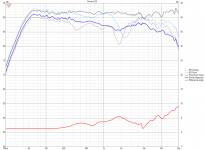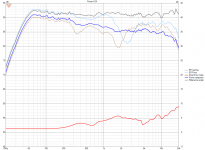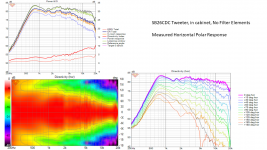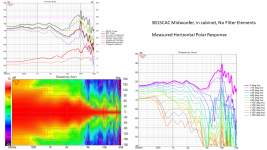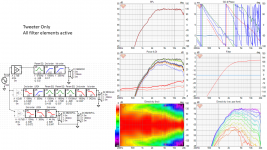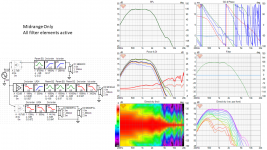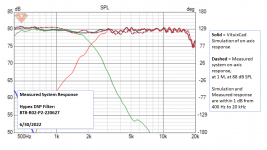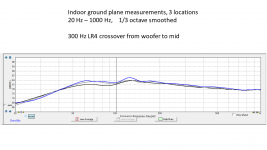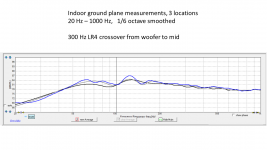Wait, what is this then? I always thought it was the option for filter behaviour of FusionAmps ("FA"). Was I wrong?There is no HFD option in VituixCAD for the sole reason, Hypex doesn't want to disclose the formulas (according to Kimmo) But I use myself generic and 96 k to approach quite closely what HFD do
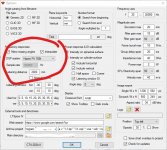
@hifijim can you post a polar graph from just the tweeter? It would be interesting to see if the polar changes because of the mid/XO. Or maybe it is just making the on-axis flat that is making the tweeter a little hot off-axis.
...
Here are some plots to chew on...
j.
Attachments
Let’s take this offline. Let’s not take a really big detour. I just wanted to show Jim what happens with acoustic LR2 vs LR4.@tktran303 What is your CTC for mid/tweeter? Sorry for the digression Jim.
Message me privately Brandon.
Last edited:
I agree that we can't say it in general, but at least on my upcoming project AND on simulation only (based on prototype front plate drivers measurements) AND M74B/T25B+Waveguide, LR2 between Mid and High was betterQuick detour-
Acoustic LR4 MF/HF:
View attachment 1067732 View attachment 1067731
same system, Acoustic LR2 MF/HF
True acoustic LR2 slopes have been long favoured by designers who have forgotten more than I know.
I could never quite understand why it was preferred. Something about allowing for a smoother blend, a smoother power response, different lobes. Or was it because it was esoteric or or “just sounds better to my ears”
And it was hard to be convinced when all I hard to stare at was a single on-axis measurement.
But now with complete polar measurements and visualisation like VituixCad2’s 6 pack; to me it appears better on all fronts, when crossing in the 2-3Khz region to a flat faced tweeter.
Historically the difficulty has been choosing drivers that are smooth enough outside of their passband (1 octave or more) that could facilitate it. You know, a tweeter that was robust enough below the crossover point, and a mid-range/woofer that is smooth enough in the stop band.
with DSP it’s a bit easier to tweek your filter to protect the drivers, so that opens up a lot of options for drivers that were previously considered too difficult to work with for acoustic LR2…
I could never quite understand why it was preferred. Something about allowing for a smoother blend, a smoother power response, different lobes. Or was it because it was esoteric or or “just sounds better to my ears”
And it was hard to be convinced when all I hard to stare at was a single on-axis measurement.
But now with complete polar measurements and visualisation like VituixCad2’s 6 pack; to me it appears better on all fronts, when crossing in the 2-3Khz region to a flat faced tweeter.
Historically the difficulty has been choosing drivers that are smooth enough outside of their passband (1 octave or more) that could facilitate it. You know, a tweeter that was robust enough below the crossover point, and a mid-range/woofer that is smooth enough in the stop band.
with DSP it’s a bit easier to tweek your filter to protect the drivers, so that opens up a lot of options for drivers that were previously considered too difficult to work with for acoustic LR2…
Last edited:
Update: I got the Hypex filter straightened out. Changing the tweeter delay made the big difference, and I also made some minor adjustments to the tweeter and mid filters and the tweeter levels. At this point, the filter elements / parameters in Hypex are very close to the VituixCad simulation parameters. The differences are:
Tweeter:
(1) Vcad 2nd order high pass filter at 1.9kHz has Q = 0.7. Hypex filter is at 1.9kHz and Q = 0.78
(2) Hypex filter has an additional 2nd order high-shelf filter at 5.66kHz, -1.0 dB, Q= 1.0
Midwoofer:
(1) Vcad 2nd order low pass filter at 1.9kHz has Q = 0.947. Hypex filter at 1.9 kHz has Q = 0.71
(2) Vcad has a Parametric EQ at 1.9kHz, -1.7 dB, Q = 5.97. Hypex filter has parametric EQ at 1.8kHz, -2.0 dB, Q = 5.5
All the other filter elements and parameters match. So as I said, minor differences.
The results look good. The VituixCad simulation and the measured system on-axis response are within 1 dB from 400 Hz to 20 kHz. Of course, below 400 Hz my gate window is too small to give a valid measurement.
I am now ready to move on to the next phase, which is hoisting this 70 lb beast onto a horizontal roller table and making vertical polar measurements. First I need to construct the roller table 🙂
j.
Tweeter:
(1) Vcad 2nd order high pass filter at 1.9kHz has Q = 0.7. Hypex filter is at 1.9kHz and Q = 0.78
(2) Hypex filter has an additional 2nd order high-shelf filter at 5.66kHz, -1.0 dB, Q= 1.0
Midwoofer:
(1) Vcad 2nd order low pass filter at 1.9kHz has Q = 0.947. Hypex filter at 1.9 kHz has Q = 0.71
(2) Vcad has a Parametric EQ at 1.9kHz, -1.7 dB, Q = 5.97. Hypex filter has parametric EQ at 1.8kHz, -2.0 dB, Q = 5.5
All the other filter elements and parameters match. So as I said, minor differences.
The results look good. The VituixCad simulation and the measured system on-axis response are within 1 dB from 400 Hz to 20 kHz. Of course, below 400 Hz my gate window is too small to give a valid measurement.
I am now ready to move on to the next phase, which is hoisting this 70 lb beast onto a horizontal roller table and making vertical polar measurements. First I need to construct the roller table 🙂
j.
Attachments
Hi as long as I remember it was Kimmo answer, and by the way what does mean 192K ? Fusion Amp are working in the eighties kHzWait, what is this then? I always thought it was the option for filter behaviour of FusionAmps ("FA"). Was I wrong?
View attachment 1067744
I wish it was typical for me. Maybe it is typical for you and hifijim.Group delay is typical for 3-way with sealed bass
Thanks, @hifijim! That tweeter is playing well under 1khz! What a crazy part.Here are some plots to chew on...
j.
If X sound sources all played a sound within 0.3ms, the ear would not be able to tell one from another. This is my understanding anyway.Something about allowing for a smoother blend
I don't think there is wisdom in past choices unless you know all of the things they were trying to solve and the methods used to solve them.
I have done outdoor ground plane measurements in the past on my earlier systems, and I got resolution down below 20 Hz. Due to uncooperative weather, I do not want to make an outdoor ground plane measurement just yet. I do, however, want to evaluate my lower crossover (300 Hz) to make sure it is valid. To do this I do not need resolution into the deep bass, I just need it near my lower crossover.
A challenge that we all face with 3-way crossovers is that the lower crossover often lies between 200 Hz and 600 Hz, and this frequency band that is often below our capability to make a gated measurement with good resolution. In my case, I have a 300 Hz crossover between the two woofers and the mid driver. Elevating my speaker as high as I can, with my best possible gate window of 4.6 ms, I have a 1/2 octave resolution down to 450 Hz. This does not inspire confidence in the measurements in the region near my 300 Hz crossover.
I experimented with indoor ground plane measurement. I made measurements with the speaker on its side and the mic flush with the ground at a distance of 1 m. I used both RTA (ungated) measurements and dual-gate measurements which blend a 5ms gate window with a 200 ms gate window. The RTA and dual gate measurements both agreed once the data was smoothed. I Measured 3 different positions to some-what average out the room modes. I also tested the technique to make sure it could pick up a deliberately misaligned filter. To me it looks like I get good valid measurements down to about 180 Hz before room modes start to dominate things.
The results tell me that my 300 Hz crossover is working as intended and is good enough for now. When I do outdoor ground plane measurements, any additional adjustment will probably be small.
j.
A challenge that we all face with 3-way crossovers is that the lower crossover often lies between 200 Hz and 600 Hz, and this frequency band that is often below our capability to make a gated measurement with good resolution. In my case, I have a 300 Hz crossover between the two woofers and the mid driver. Elevating my speaker as high as I can, with my best possible gate window of 4.6 ms, I have a 1/2 octave resolution down to 450 Hz. This does not inspire confidence in the measurements in the region near my 300 Hz crossover.
I experimented with indoor ground plane measurement. I made measurements with the speaker on its side and the mic flush with the ground at a distance of 1 m. I used both RTA (ungated) measurements and dual-gate measurements which blend a 5ms gate window with a 200 ms gate window. The RTA and dual gate measurements both agreed once the data was smoothed. I Measured 3 different positions to some-what average out the room modes. I also tested the technique to make sure it could pick up a deliberately misaligned filter. To me it looks like I get good valid measurements down to about 180 Hz before room modes start to dominate things.
The results tell me that my 300 Hz crossover is working as intended and is good enough for now. When I do outdoor ground plane measurements, any additional adjustment will probably be small.
j.
Attachments
Thanks, @hifijim! That tweeter is playing well under 1khz! What a crazy part.
When I used this tweeter before, I was able to take it down to 1800 Hz with a 4th order filter. However, distortion starts to be a problem if it is pushed much lower than that. With a waveguide I am sure it can go lower.
Hi Jim
Another trick you could perhaps try is to wire your woofer out of phase with your midrange, and take at measurements. If you have a sharp deep null, I think you can be confirdent your phase matching at the LF/MF is good. However you’re still left with uncertain SPL levels. Which is always difficult in domestic living room Le because, as you say, the crossover frequency anything around 80Hz to 500Hz below the Schroeder frequency.
I always correlate ground GP AND/OR baffle step compensated near field merged with far field WITH in-room measurements, but which should I go on.
There’s no doubt that to me, the system isn’t complete without in room compensation/EQ below the Schroeder frequency.
And why sub/sat systems are generally inferior to 3 fully integrated full range 3 or 4 way systems.
All the pros do this. And when I say pro, I mean profession. People who are doing this for a job, and their bread relies on this. On location sound guys; cinema/theatre installers, large recording studios. Even the working musician who’s side gig is renting out his PA gear to DJs who play at the local pub on the Saturday night…
Another trick you could perhaps try is to wire your woofer out of phase with your midrange, and take at measurements. If you have a sharp deep null, I think you can be confirdent your phase matching at the LF/MF is good. However you’re still left with uncertain SPL levels. Which is always difficult in domestic living room Le because, as you say, the crossover frequency anything around 80Hz to 500Hz below the Schroeder frequency.
I always correlate ground GP AND/OR baffle step compensated near field merged with far field WITH in-room measurements, but which should I go on.
There’s no doubt that to me, the system isn’t complete without in room compensation/EQ below the Schroeder frequency.
And why sub/sat systems are generally inferior to 3 fully integrated full range 3 or 4 way systems.
All the pros do this. And when I say pro, I mean profession. People who are doing this for a job, and their bread relies on this. On location sound guys; cinema/theatre installers, large recording studios. Even the working musician who’s side gig is renting out his PA gear to DJs who play at the local pub on the Saturday night…
Last edited:
Yes, I agree. it is good to get correlation between two different measurements of the same phenomenon. For design purposes, I use the technique of merging near field response (compensated for baffle step) to gated far field response. However, there is some subjective judgment calls that must be made when doing the merging process. It is possible to arrive at two different response curves which differ by a couple of dB in the lower end, both of which are reasonable. Because of this, when I do system level evaluation, I try to avoid the merging process. I was looking for a way to directly measure the 200 - 600 Hz region without going outdoors... I am please that I stumbled upon this indoor ground plane idea...I always correlate ground GP AND/OR baffle step compensated near field merged with far field WITH in-room measurements, but which should I go on.
I am glad this process works well for you. For me I don't care for the way it seems to change the character of the bass in music. That said, my room is pretty well behaved, so I don't have a big need for room correction.There’s no doubt that to me, the system isn’t complete without in room compensation/EQ below the Schroeder frequency.
my blend, which I do in accordance with this technique:
(except I now do it in VituixCAD)
http://audio.claub.net/software/FRD_Blender/White Paper - Accurate In-Room Frequency Response to 10Hz.pdf
later I did the GP technique, first in a field (not enough power cabling, ground not completely flat ) second on a soccer pitch (ground still soft, too loud much background noise)
But when did finally completed it successfully in fine weather, lined up perfectly with the late Jeff Bagby’s blend technique.

so now I wonder if I should bother with outdoor GP… so much work and so dependant on fine weather…
(except I now do it in VituixCAD)
http://audio.claub.net/software/FRD_Blender/White Paper - Accurate In-Room Frequency Response to 10Hz.pdf
later I did the GP technique, first in a field (not enough power cabling, ground not completely flat ) second on a soccer pitch (ground still soft, too loud much background noise)
But when did finally completed it successfully in fine weather, lined up perfectly with the late Jeff Bagby’s blend technique.
so now I wonder if I should bother with outdoor GP… so much work and so dependant on fine weather…
Last edited:
I cannot argue with anything you wrote. I have a copy of the Jeff Bagby white paper which I refer back to all the time. A year ago I did a comparison of outdoor ground-plane measurement to the NF technique, and I found they agreed very closely, easily within the limits of my measurement uncertainty.
post #124
https://www.diyaudio.com/community/threads/new-active-satori-textreme.366347/page-7#post-6565109
So my desire to confirm/refine my lower crossover with a ground plane measurement is more for my peace of mind, for a sense of thoroughness or completeness.
post #124
https://www.diyaudio.com/community/threads/new-active-satori-textreme.366347/page-7#post-6565109
So my desire to confirm/refine my lower crossover with a ground plane measurement is more for my peace of mind, for a sense of thoroughness or completeness.
This could well be another thing that might take some time to come around to, like the faceted baffles 🙂I am glad this process works well for you. For me I don't care for the way it seems to change the character of the bass in music. That said, my room is pretty well behaved, so I don't have a big need for room correction.
When done right equalizing the bass in room is a significant improvement and certainly you would know it when you hear it.
There is also the possibility of having grown accustomed to the sound as it is. I found this when equalizing headphones, at first I didn't like it because I had got used to it sounding different. After a little while I couldn't go back to having the EQ off, a similar mechanism to how mix engineers get used to their speakers and set up and can produce great work that translates well, even if when measured the response of the monitors is less than ideal.
It is no surprise that on most occasions the two will agree very well and could easily make you think, why bother with the difficult way, when you get the same answer. The problem with this as an assumption is that issues can hide in the reduced resolution region between 400 and 800Hz. If the speaker does not have an odd resonance in that region they will be the same, but if it does the spliced gate can hide it and the longer window type of measurement will show it.A year ago I did a comparison of outdoor ground-plane measurement to the NF technique, and I found they agreed very closely, easily within the limits of my measurement uncertainty.
I think this is perfectly reasonable, another way to check if anything might be hiding is to do close up measurements around the woofer and cabinet to see if anything odd shows up, if there is nothing untoward then it would be reasonable to assume the splice is good enough.So my desire to confirm/refine my lower crossover with a ground plane measurement is more for my peace of mind, for a sense of thoroughness or completeness.
There is also the possibility of having grown accustomed to the sound as it is. I found this when equalizing headphones, at first I didn't like it because I had got used to it sounding different. After a little while I couldn't go back to having the EQ off, a similar mechanism to how mix engineers get used to their speakers and set up and can produce great work that translates well, even if when measured the response of the monitors is less than ideal.
the ear/brain is a remarkable thing. this is common phenomenon and one that probably happens a LOT more than people are aware, or care to admit.
For instance, here is a in-room measurement at the listening position of one of my favourite speakers (Jim Holtz/Curt Campbell Statement II)
Once I equalised out the boost between 30Hz and 80Hz, I didn’t like it… so after awhile I took it out.
There, I said it. I like it the way it was- with lots of bass, in my room.
Last edited:
That doesn't surprise me. The relative level of bass to treble and slope up or down has a big influence to what sounds balanced. Things that measure quite differently can sound surprisingly similar. Much like how the smiley face EQ ends up being put in place, add a bit of bass, now it needs more treble, too much add some more bass, wait now it needs more treble.Once I equalised out the boost between 30Hz and 80Hz, I didn’t like it… after awhile I took it out.
There, I said it. I like more bass.
Talking about time to come a round to… facets, DSP with linear phase EQ, active power amplification, near perfect on axis and off axis response, small place it anywhere size, and full frequency (range) response. All available a generation ago:This could well be another thing that might take some time to come around to, like the faceted baffles 🙂
https://www.stereophile.com/standloudspeakers/1105nht/index.html
The adoption rate of these things genuinely puzzles me.
What’s the limitation?
price?
brand (image)?
consumer (lack of) interest?
Because it was SOTA when it was developed around 20 years ago.
Most DIYers are not doing anything new that @Jack Hidley didn't do 20 years ago. Truly ahead of his time.
Industry veteran Jack may be a fantastic interviewee for @bikinpunk or @jtwrace
Last edited:
- Home
- Loudspeakers
- Multi-Way
- New Project - tower 3-way with twin 8s
